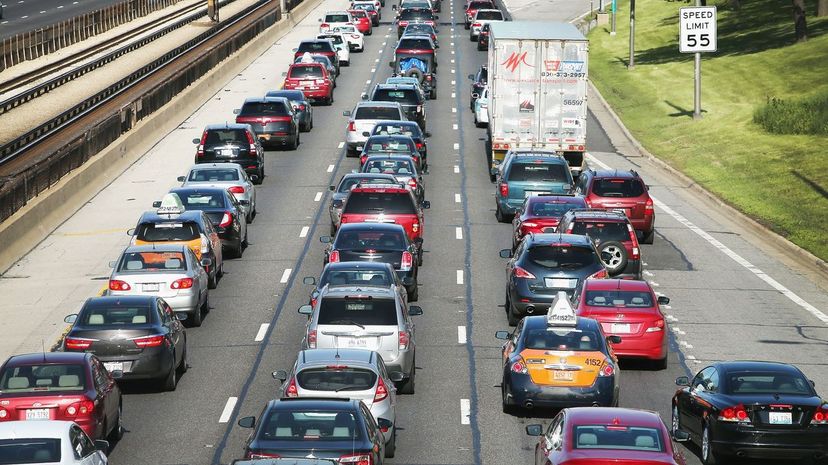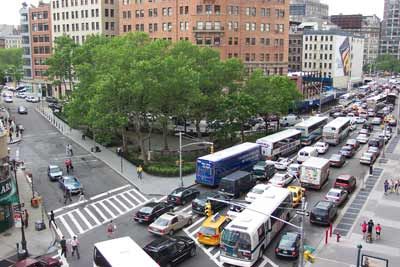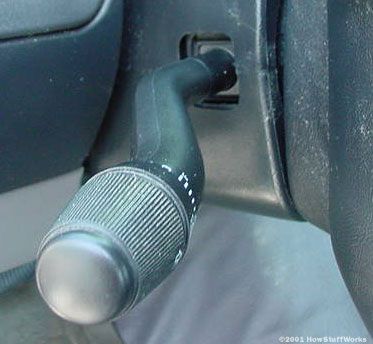
Despite being the law in most U.S. states, too many drivers still don't use their turn signal. Traffic-weary Californians are notoriously allergic to signaling.
"Turn signals on most Californian cars are just vestigial organs, useful only in case the car needs to be resold out of state," writes Hamish Reid on his blog California Driving: A Survival Guide."
Advertisement
Reliable stats on turn signal use are slim, but the best estimates suggest that drivers in the U.S. and Canada fail to signal turns at intersections roughly 25 percent of the time. Lane changes are even worse. The one and only study on record found that drivers in Dayton, Ohio, failed to signal lane changes 48 percent of the time.
Here are seven situations in which you are least likely to use your turn signal.
1. Nobody's Around
John Sullivan of the University of Michigan Transportation Research Institute confirms that drivers behave better when there are more cars around.
"If you're on a local road in your neighborhood where there's much less traffic, there's a lot less signaling, too," says Sullivan, who conducted an extensive turn signal study in 2014. "You're almost five times more likely to signal on a major or minor surface road than on a local road."
If you think it's safe to not signal on local neighborhood and country roads, you're dead wrong. Car insurer Esurance shares some scary stats; not only do more accidents take place within 25 miles (40 kilometers) from your home, but more fatal crashes happen on rural country roads than busy urban areas.
2. It's Only a Right Turn
Drivers are actually pretty darn good at signaling left turns. According to a 2013 turn signal study by Harold Faw of Trinity Western University in Canada, an impressive 94.8 percent of study participants in British Columbia signaled a left turn from a dedicated left turning lane.
The worst signalers in Faw's study, with a sorry 74 percent signal rate, were pickup trucks (no judgment) making right turns from a dedicated right turning lane.
This makes sense, of course, since a left turn is potentially a much more dangerous move than a right turn. By signaling a left turn, not only are you letting the people behind you know that you're slowing down and potentially stopping in the middle of the road, but you're telling opposing traffic know that you're about to cut across. If it's a four-way intersection with pedestrians, everyone benefits from a heads up.
In comparison, right turns are downright boring. But that won't stop a cop from giving you a ticket for not putting on your indicator.
3. The Guy in Front of You Didn't Use His Signal
Faw focused part of his research on busy intersections where drivers might be influenced by the behavior of other cars. He found that signal use, both good and bad, can be contagious.
"The signal use rate for drivers following a vehicle with its signals on was approximately 6 percent higher than the rate for drivers following a vehicle not using signals," writes Faw.
While that's not a huge effect, it shows that on some level, conscious or subconscious, we model the driving behavior of those around us. Which might help explain California drivers.
4. You're in the Back of the Line
At those same busy intersections in British Columbia, Faw found another strong motivator for bad signaling. Drivers who were closely following a car in front of them were 7 percent less likely to signal a right turn than drivers who pulled up to the same intersection without a car in front of them.
If you pull up behind a line of cars in a dedicated right turn lane, you might assume that everybody already knows where you're going, so what's the point of signaling? You might be right, or you might also run over the pedestrian who assumed you were going straight because your signal wasn't on. Oops.
5. Signals are a Pain to Turn Off
Turn signal technology has gone largely unchanged since the 1940s, when engineers first built a mechanism into the steering column that automatically shuts off the signal after the driver completes a turn. But that mechanical switch can fail when you merge into traffic or change lanes, which is why the Cadillac in front of you has been signaling left for the past 47 miles (76 kilometers).
According to a 2006 survey by Response Insurance, 17 percent of drivers who admitted to not signaling said that "[forgetting] to turn it off" was the reason for their negligence.
Richard Ponziani, a veteran automotive engineer from Ohio, has invented a software fix called Intelliturn that tells the vehicle's computer when the car has completed a turn, instead of relying on the mechanical "click" of the steering column. Ford has licensed the technology in many its trucks and SUVs.
Ponziani, was also the author of the study we mentioned earlier that looked at lane-changing habits. To prove the need for an automated turn-signal reminder system — another one of his patents — he drove his car around the streets of Dayton for a year recording people's turn signal habits. Which brings us to reason No. 6.
6. You're Secretly a NASCAR Driver
In Ponziani's excursions around Ohio, he recorded data from 2,000 lane changes and found that 48 percent were executed without a signal. But even that sad stat is significantly better than the 57 percent who claimed not to signal when changing lanes in the 2006 Response Insurance survey.
Among the lame reasons given for not signaling — "not enough time" (42 percent), "lazy" (23 percent), "It's not important" (11 percent) — the most disturbing is the 7 percent of survey respondents who said they don't signal because it "adds excitement to driving."
You've seen these people, weaving through four lanes of traffic like they were gunning for a new high score on Pole Position. As "exciting" as it is for the Mario Andretti-wannabe in the Honda Civic, the rest of us think of the highway less as a source of "excitement" than a way to get home from work, preferably alive.
7: You like to Live Dangerously
Until we're all driving wirelessly connected self-driving cars (hurry up, Google) your turn signal is the most effective means for communicating with other drivers. It's also one of the most powerful safety devices you have for avoiding accidents.
"A seatbelt saves you when you're in a crash, but a turn signal is crash prevention," Ponziani says. "That's the tragedy; that it's on our cars, but we're not using it."
There are no reliable numbers for how many accidents are caused by turn signal neglect, but it's safe to assume that better communication between drivers will lead to fewer accidents. And it's far more dangerous to assume that signaling in certain situations just isn't important.
Advertisement

